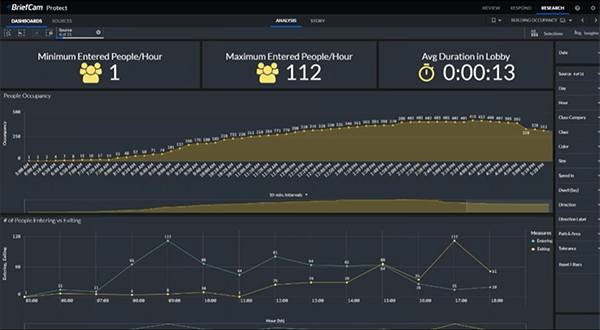Why is Intelligent Video Surveillance Important for Businesses?

Uncover Information Buried in Footage
Video surveillance has been widely used and valued by businesses for over 30 years, primarily as a cost-effective workplace safety and security tool. Companies commonly use CCTV cameras to amplify the efforts of a physical security team, including monitoring areas either on site or remotely in real-time, as well as gathering video evidence for post-incident investigations. As CCTV technology evolves, businesses increasingly realize that there is a wealth of valuable data buried in video footage that could be used for purposes beyond safety and security. However, businesses don’t have enough manpower or time to manually and precisely review the high volume of video footage and analyze the millions of objects and interactions that have been captured.
The answer to this problem is video intelligence software, which turns raw video footage into quantitative, qualitative and actionable data. Powered by AI and Deep Learning, video analytics systems can extract, recognize, and classify objects in video, including vehicle types, from bicycles to motorcycles and trucks, as well as men, women, children, and animals. Such systems can also detect subtle events, such as a change in illumination, or a person or vehicle dwelling in a predefined location for an unusually long period of time. This enables video analytics operators to conduct sophisticated searches for objects or events in archived footage and increase real-time awareness of unfolding situations.
Accelerated Video Review
Rapid forensic review of video footage is critical to accelerate investigations, accurately assess criminal incidents and support workplace compliance investigations. Extensive search and filter functions in a video content analytics system make it easy to review many hours of footage in a matter of a few minutes by filtering and focusing on relevant criteria. Security teams in any organization can use this functionality to save time and ensure accuracy in their investigations, while also creating opportunities to break video surveillance out of the physical security siloes and increase effectiveness and efficiency for other teams that might find value in the events and behaviors that can be better understood based on video analysis.
Research Trends in Video
Video content analytics software also aggregates data, which uncovers patterns and trends that managers can use to make better decisions. This business intelligence is helpful to nearly all industries, such as banking, healthcare, retail, transportation, and urban planning. Video analytics systems can deliver quantitative and qualitative data over periods of time, enabling operators to build custom business intelligence dashboards that present information such as traffic volume, common pathway heatmaps, and demographic visitor data. For example, a grocery store may want to learn how long customers dwell in a particular area of a store, how many customers utilize the store on an hourly basis, what percentage of customers are men, women or children, and which aisles in the store are most popular. That same manager may also use video content analytics need to prove compliance with health and safety mandates, such as face masks to prevent COVID-19 infections, or building occupancy regulations.
Real Time Response
By providing trend data, video analytics systems also enable operators to define normal thresholds or benchmark conditions. Those benchmarks can then be referenced to configure rule-based alerts that are triggered by anomalous behavior. The system sends the real-time alert to an operator so that operator can be aware of and respond to situations as they are evolving. For example, a security officer may overlook a lighting change in a hospital drug storage closet, a person lying injured on a warehouse floor, or a crowd forming near a retail checkout register. In contrast, a video analytics system can alert to such incidents, notify the system operator and allow for rapidly determining an appropriate response. In addition, some video analytics systems include facial recognition and license plate recognition alerts so that operators can compile a digital watchlist of faces or license plates; when a face or plate on the watchlist appears in a live video feed, the system can alert the operator. The watchlist can include either persons of criminal interest (shoplifters, disgruntled former employees, or terrorist suspects), or it may consist of VIP guests so that entertainment and hospitality managers know when a consenting visitor has entered the store or premises and should receive prompt service.
Face re-identification is an extension of facial recognition, whereby a video content analysis system can recognize individuals as anonymous, unique visitor identities; in order to allow the system to differentiate between recognized employees and anonymous guests, and analyze aggregate and unique guest traffic. This is a powerful way for businesses to accurately distinguish between visitor and employee traffic, measure unique visit duration, track site navigation, and quantify repeat and bounced visitor traffic.
By complementing their video surveillance networks with video content analytics, businesses increase efficiencies, not only for security teams, but also for planning, operations, customer service, marketing, and property management departments. It is a logical technology step to derive more value from an existing video surveillance system.
Signup to receive a monthly blog digest.
